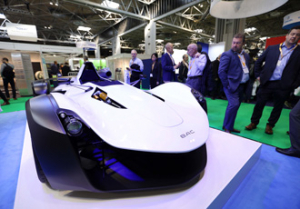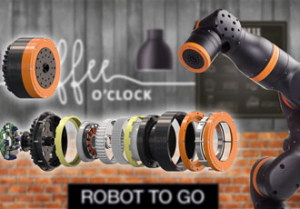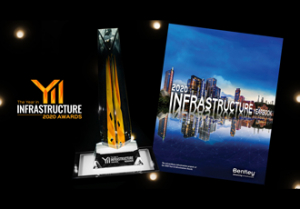More "lightness" and resource efficiency in mechanical and plant engineering
When "EXPERIENCE COMPOSITES powered by JEC Group," the new major international trade show for composite fiber materials and lightweight construction, opens its doors for three days on September 21st, 2016, the use of carbon and related materials in mechanical and plant engineering will play an important role. The collaborative project from Messe Augsburg, Carbon Composites e.V. and JEC Group will display composite fiber innovations and projects for mechanical and plant engineering in one of six industry display windows. Renowned exhibitors from the industry, research institutions and universities will vividly depict what new materials can do in the machine and plant engineering industry, including increasing resource efficiency and development of mass production.
Resource efficiency: a factor for success
The market for resource-efficient machines and plants is a growth market. Through consistent lightweight construction and the use of innovative composite fiber materials, the energy expended for greatly accelerated masses can be significantly reduced. In the case of products such as drive shafts or gripper systems, this leads to significant productivity advantages. Production volumes can be increased as a result of shorter cycle times, with the help of increased acceleration and less moving mass. There is great potential in the development of entirely new, groundbreaking fields of application. Professor Andre Baeten from the University of Applied Sciences Augsburg describes one scenario: "For one thing, I see a strong future in the use of composite fiber materials in mechanical energy storage systems and, of course, e-mobility concepts. For another, great effects can be achieved by functional integration in composite fiber machine components. Here I am thinking of sensor equipment for sound emissions, forces and torque or online operational monitoring. Composite fibers are therefore considered to be an important key factor in Industry 4.0."
Development and applications
Composite fiber materials have long been a subject of interest in mechanical and plant engineering. At first, materials were tested in individual applications for specialized niches, such as tool holders, grippers or extension sleeves. System solutions that integrate the design, the manufacturing and the service of drive shafts or paper rollers made from composite fibers were soon in demand. Today, we see a broad range of applications and the development of new markets, such as in the machine tool industry, in conveyor systems engineering or in transport and logistics systems, where lightness is a key factor. Composite fiber materials are successfully used today in power transmission (e.g. drive trains, drive shafts of cars, CFRP pump impellers), in engine components (intake manifolds of internal combustion engines made from CFRP), in highly dynamic components of textile machines, in transportation (e.g. shipbuilding) or in printing and paper technology (paper rollers made of CFRP in paper machines).
Groundbreaking collaborative projects: MAI Carbon, FORCIM3A
The leading-edge cluster MAI Carbon undertakes numerous endeavors, such as in connection with the "MAI Span" project for developing a hybrid lightweight construction clamping chuck with integrated extraction. The FORCIM3A funding project, an association of pertinent companies and research institutions, is likewise investigating the overcoming of hurdles in the use of composites in mechanical and plant engineering. This particularly focuses on mixed construction of CFRP and metal, such as for shafts, rollers, wave compensation elements or support arm structures.
Manufacturing methods and technologies used
"The most common manufacturing methods used today include the winding technique for rotation-symmetrical composite components, such as for drive shafts and paper rollers. In the case of three-dimensional stiffening elements, we primarily rely on the braiding technique. Pultrusion is used for stiffening elements and simple profiles, and wet pressing has proven efficient for flat structural elements and large quantities," says Professor Andre Baeten, explaining the production environment. "The technologies that are used are especially pre-forming with pasted inserts and functional elements, metallic interfaces to machine components such as screws, bearings and gear wheels, and the sandwich construction method for functional integration," continues the Professor of Lightweight Construction and Composite Technology in the Faculty of Mechanical and Process Engineering at the University of Applied Sciences Augsburg.
Strong resonance from mechanical and plant engineering
For Philip Häußler, Project Manager of "EXPERIENCE COMPOSITES powered by JEC Group," a strong mechanical and plant engineering presence at this exhibition is particularly important: "This sector is a cornerstone of German industry and traditionally has also been especially strongly anchored in our region. We want to show how composites applications and lightweight construction can provide new impetus to mechanical and plant engineering. Our exhibitors will provide live presentations of everything that is already possible and where development is headed." There is also great interest on the part of the machine and plant engineering industry to present at the new leading exhibition in Augsburg. Dr. Markus Lang from Voith Composites says: "We are looking forward to the new exhibition in Augsburg. We anticipate many incentives, good discussions and profitable contacts. It is important to us that true innovations can be seen in Augsburg. And, of course, we want to promote our business. Those companies in particular who are looking to get started with new applications of composite fiber materials and lightweight construction will be coming to Augsburg. We expect that the organizers of this exhibition will have lots of new ideas and that we will experience a really great event. The fact that the renowned JEC Group and the CCeV network are on board was another reason for us to take part."
Future trend of hybrid construction
The specialist Baeten sees a strong trend in the use of composite fiber materials in mechanical and plant engineering: "Of course, I'm thinking of the sandwich construction method for function integration. But we also frequently discuss with companies the connecting of composite fiber machine elements using metallic interfaces, such as drive shafts made of CFRP or with connection pieces made of steel." Andre Baeten is certain that composites will massively enrich machine and plant engineering, in machine elements, machine tools, robots and automation elements, in measurement and testing technology, the packaging industry or fluid technology. "CFRP and lightweight construction in machine and plant engineering means resource efficiency. This, in turn, lowers costs. And this is precisely where our event will provide new impetus. CFRP in the machine and plant engineering industry will be a topic of discussion in even more companies after our exhibition," says Philip Häußler, describing his and his team's ambitious goals.












Write a comment
No comments